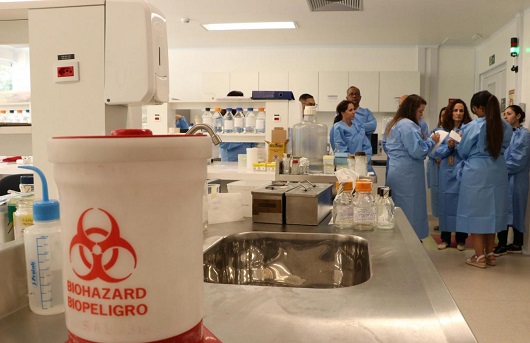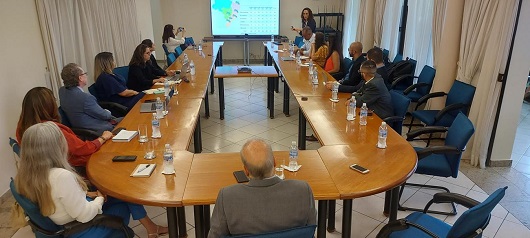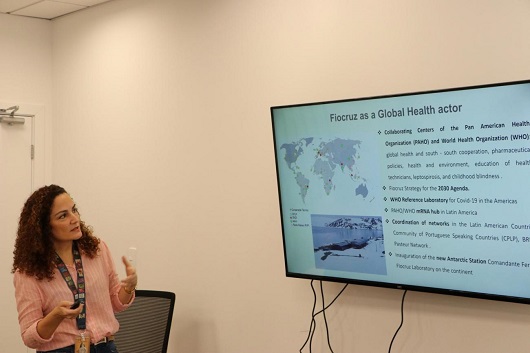CDC team visits Fiocruz to monitor progress of the antimicrobial resistance surveillance project
31/05/2023
Cristina Azevedo (Fiocruz News Agency)
Two years after its start, the project for the Strengthening of the Brazilian Antimicrobial Resistance Surveillance System already has a network of 25 sentinel hospitals and 10 Central Public Health Laboratories (Lacens) across the country. In its third year, it should reinforce training to increase quality control and standardize operations in different regions, and then continue expanding this network. The balance was part of the results and proposals presented last Friday (19/5) to the Technical Group of the Centers for Disease Control and Prevention (CDC) of the United States, at Fiocruz. Accompanied by representatives of the Ministry of Health and Anvisa, for ten days its members toured the hospitals and laboratories that are part of the project. For the CDC, Brazil is a strategic partner in South America and may provide assistance to neighboring countries in the future.
The CDC team visited the Hospital Infection Research Laboratory (Lapih), at the Oswaldo Cruz Institute (photo: Peter Ilicciev/Fiocruz)
“One of the topics I have been discussing with our office in Brasília is how to think about Brazil's role in the region. At the CDC, we have received numerous requests for assistance. The world is too big. It is strategic to have partners who can extend this assistance to neighbors”, commented Fernanda Lessa, a Brazilian who heads CDC's International Infection Control Program and who participated in the meeting at the Official Residence via Internet from Atlanta. “Combating antimicrobial resistance is crucial for CDC Atlanta and the World Health Organization. Fiocruz is a strategic partner in this area. And these activities can act as seeds for national policies. We want to see how this project can be expanded to the region”, added Juliette Morgan, director of the CDC Regional Office for South America, in Brasilia.
Representing President Mario Moreira, who was in Geneva for the World Health Assembly, the special advisor to the Presidency, Rodrigo Correia de Oliveira, noted that Fiocruz's structure enables it to assume this role. “The Foundation is present in 11 Brazilian states, which puts it in a better position to collaborate with different laboratories of the Ministry of Health and even with surrounding countries. Antimicrobial resistance is a priority for Fiocruz as well”.
Changes for next year
Microbiologists Danielle Lower and Sarah Sabour, from CDC Atlanta, arrived in Brasília on the 8th and visited hospitals and Lacens in the Federal District, Minas Gerais, São Paulo and Paraná before arriving at Rio. On Thursday, the 18th, accompanied by Magda Costa and Janaina Salas, from Anvisa; Renata Tigulini Peral, from the Ministry of Health; and André Luiz Abreu, from Fiocruz Brasília, visited the Hospital Infection Research Laboratory (Lapih), at the Oswaldo Cruz Institute (IOC/Fiocruz), where they attended a more technical presentation by the main researcher of the project and head of the laboratory, Ana Paula Assef. The group also got to know the Biobank.
On Friday, the 19th, in addition to Correia, the group was received by the vice-president of Research and Biological Collections, Maria de Lourdes Aguiar Oliveira; by Tania Fonseca, from the Coordination of Health Surveillance and Reference Laboratory (CVSRL/Fiocruz), and by Ana Paula's team, for a broader meeting. Later, its members visited the Moorish Castle.
The CDC team sees the advances of the project for the Strengthening of the Brazilian Antimicrobial Resistance Surveillance System at Fiocruz (photo: Peter Ilicciev)
The project is the result of a partnership between Fiocruz, the Ministry of Health – through SVSA/DAEVS/CGLAB; Lacen/PR (which shares with Lapih/Fiocruz the position of National Reference Laboratory for the Project) and the Federal University of São Paulo (Unifesp), with the Special Mycology Laboratory (Lemi) and the Special Clinical Microbiology Laboratory (Lemc) as associated laboratories. The Project is funded by the CDC and its main objective is to support the Ministry of Health in structuring the Antimicrobial Resistance Monitoring Network, in line with the National Action Plan for the Prevention and Control of Antimicrobial Resistance – PAN-BR.
In the second year, Anvisa also joined the project, which aims to reinforce the detection of multidrug-resistant bacteria and fungi (Candida spp.) in hospitals, train professionals and enable faster responses. The Ministry of Health, in charge of the National Network of Public Health Laboratories, is responsible for the institutional articulation, information systems and logistical support. Expected to be in force until 2026, the project's results should be incorporated into Antimicrobial Resistance surveillance actions and policies in the country.
Data collected by sentinel hospitals are sent to BR-GLASS, part of a global surveillance platform (Global Antimicrobial Resistance Surveillance System). "The development of this national platform will be key to understanding the resistance profile in the country and supporting decision-making by health managers on this issue. Tests are also being carried out on the susceptibility of microbes to new drugs that are arriving in Brazil – important data to support hospitals in deciding which is the best drug to use. The regional laboratories are receiving training to implement the detection of resistance genes by PCR in real-time, in a work that has intensified the efforts for standardization of quality control", as explained by Ana Paula in the presentation referring to the strategy for bacteria.
The second strategy, referring to the Candida spp., important in hospital infections, includes the same hospitals and laboratories. It is intended that the information also will be included in BR-GLASS. “We want to improve the identification and detection of Candida resistance in hospitals, train professionals to identify different Candidas, mainly the Candida auris, which is currently a major problem”, informed Ana Paula.
"The development of this national platform will be key to understanding the resistance profile in the country", said Ana Paula (photo: Peter Ilicciev)
Training in mycology and bacteriology was carried out with sentinel hospitals, Lacens and regional reference laboratories. For the third year, face-to-face training should also take place. And the idea is that trained professionals become multipliers, training colleagues.
“When we look at other surveillance projects, we see how this one, still in its early days, is already a success, as we usually start with a small number of hospitals and laboratories. But now we can move faster. The most important thing is to go beyond antimicrobial resistance. Currently, it already includes mycology, one of the most important gaps that we have in public health”, said vice-president Maria de Lourdes. “In no country is it easy to implement a program like this. They are different states, different policies, we are a Federative Republic”.
The very size of Brazil makes it difficult and imposes adaptations to the strategies for each region. For the quality control program, for example, laboratories have 20 days to respond to a questionnaire. But the material takes 14 days to arrive in Acre, leaving less time for analyses and responses.
“It is very difficult to carry out a work like this, with this quality, in two years, even more so in a country the size of Brazil. There was capacity to respond to different demands. And it was very well done”, summarized Tania, who also highlighted the importance of training the Lacens to know “what is happening in the states”.
Some of the recommendations presented by CDC representatives after the visit were already included in the plans for the third year of the project, such as strengthening of the training, training of multipliers and harmonization of testing methods. Some ideas from the project team in Brazil include using Fiocruz's Virtual Campus or the Open University of SUS (UNA-SUS) for training and improvement of teaching material, taking into account the different levels seen among professionals. Another idea is that information on sequencing be entered in CABGen (https://aureus.procc.fiocruz.br), a site hosted at Procc that includes different software for quality control, genome annotation, search for resistance genes, mutations related to resistance, all automated.
“This project brings a new legacy in surveillance, it contributes to how to think about a policy, to build actions to control and prevent. Another legacy is that it has already established a network. We know the level of difficulty. It will serve as the basis for responding to health emergencies. For Fiocruz, it is a pleasure to cooperate with the CDC. We have other points that we can improve. But we are in the right track”, said Maria de Lourdes at the end of the meeting.
Also participating in the meeting at the Official Residence were Marcelo Pillonetto, from Lacen Paraná and coordinator of laboratory activities in the project; Heloisa Setta, acting in the administrative part of the project; Claudio Rocha, from the Laboratory of Applied Bacteriology, Unified Health and Antimicrobial Resistance; and Bruna Ribeiro Sued Karam, from Lapih. Several other members of the CDC, the Federal University of São Paulo, Anvisa and hospitals in Minas Gerais and Brasília participated in the meeting, online.


